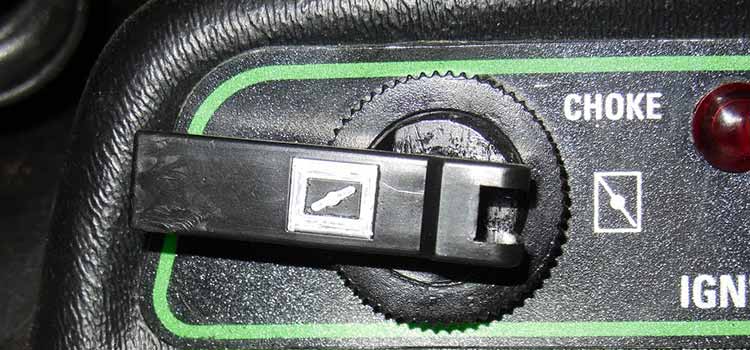
After spending a Friday evening putting a fuel filter and new plugs in my snowmobile, I was excited to go riding. But to my disappointment, once I got the machine started it would only run on choke. What’s that all about? I did some research and talked to my mechanic friend about why my snowmobile only runs on choke. Here’s what I found.
A snowmobile ‘only runs on choke’ when the engine runs lean and is not getting enough fuel. There are two possibilities, either the supply of gas is restricted, or the air is leaking into the carburetor/engine. This causes the gas/air mixture to be out of balance and doesn’t allow the snowmobile to run unless you restrict the air by keeping the choke open.
Let’s see if we can solve this problem on our own and avoid a costly trip to the shop.
Start at the carburetor
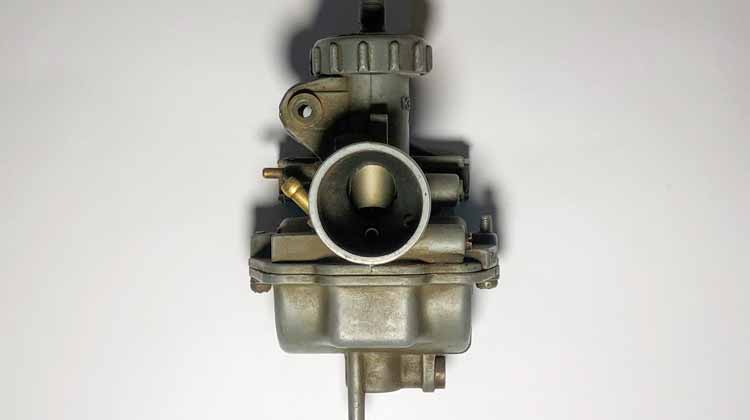
A carburetor supplies a composition of air and fuel to the engine. There are many small parts inside the carburetor, like the main jet, the pilot jet, the needle, and seat, etc. The main jet supplies the fuel, the pilot jet controls the amount of fuel when idling, and the Venturi controls the flow of air. They are tiny, and they can easily get blocked by dirt or debris.
When your snowmobile only runs on choke, your engine is starving for fuel, and the choke compensates for the low supply of fuel in the carburetor by restricting the air. This way the mixture gets richer and helps to keep your snowmobile running.
Modern ethanol gas is the worst thing that ever happened to small engines. The ethanol mixed in the fuel can cause issues when you store your snowmobile and do not drain the gas from the fuel tank and the carburetor. A gum-like residue will form inside the carburetor that can restrict the flow of fuel. To clean the carburetor, you will need to remove it from your snowmobile and disassemble it. It is not difficult but requires (a lot of) patience to make sure you do not damage any parts in the cleaning process. To remove and disassemble the carburetor, you will need a few tools. Here’s what I recommend you to get started on the job.
- A basic screwdriver set.
- Adjustable wrench.
- Socket or ratchet set.
- Needle nose pliers.
- Respiratory mask, eye protection, and a pair of work gloves will make you look more professional. Always wear protection whenever you are fixing something on your snowmobile.
You can read my detailed blog post on how to disassemble and clean the carburetor in easy to follow steps, along with pictures. It will take about an hour to understand the process and follow it.
You can use any carb cleaner. I prefer to use WD-40 Specialist Carb/Throttle Cleaner. One can should allow you to complete the process 3-4 times with excellent results. I have also tried Berryman’s Carb Cleaner and had great results too. For cleaning jets and small holes, you will need a special cleaning kit. These kits contain brushes and needles of different sizes so you can clean the carburetor properly without damaging it. These kits are readily available on Amazon, and this is the one I use mostly. I always have a pack or two in my garage, so I do not need to go looking every time I want to clean the carburetor or throttle body on any of my vehicles.
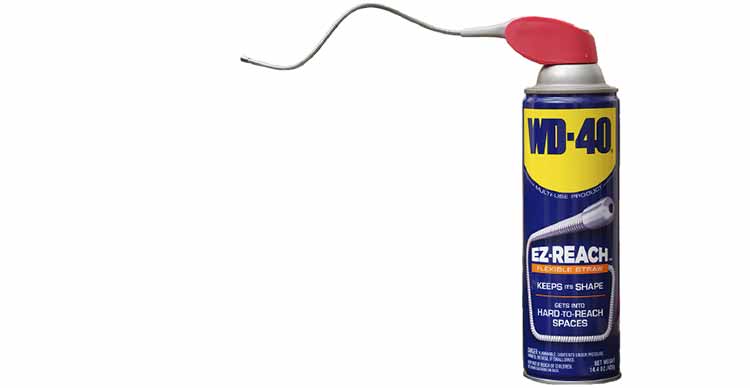
The most important thing is the reassembling of the carburetor. You must set/adjust the screws and valves back to a perfect position where it makes the exact composition of fuel and air. If you are not patient, you may mess it up. Or you can pay a mechanic to do this for you. But that’s no fun in my book, it’s too costly!
If you still can not run your snowmobile with the choke off, here are some other things that could be wrong with your carburetor.
Misadjusted carburetor
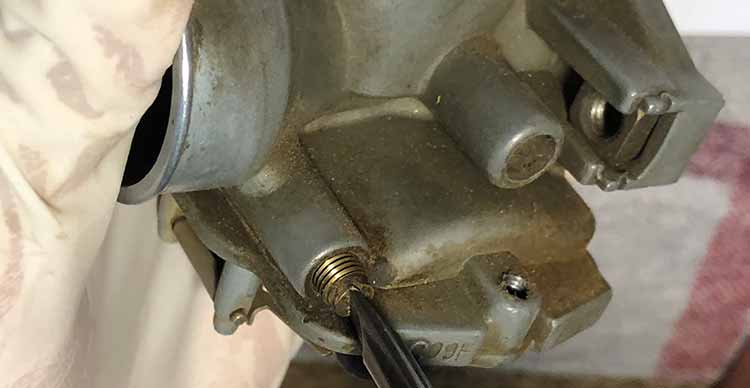
As I talked earlier, adjusting the carburetor for just the right mixture of air and fuel is very important. Too lean, you’ll have a hard time starting, too rich, and you will have backfires. There are adjustment screws that you can turn to adjust or change the flow of air and fuel to get the perfect mixture of air to fuel ratio. It is not uncommon for these screws to lose their original position because there are a lot of vibrations when we drive our snowmobiles. Fixing this problem isn’t hard but requires a bit of practice and patience. Sometimes there are markings on the screws that indicate which way it is going to open or close the valve. Start from adjusting a little, one at a time, and soon your snowmobile will be running just like a new one.
Idle screw

This screw can also get loose due to vibrations when driving your snowmobile. This screw adjusts the flow of fuel when you are not accelerating, and your snowmobile is running idle. If this screw is misadjusted, it will send either too much or too little fuel to your snowmobile when idling. Adjusting it also very simple and easy, and all you need is a flat head screwdriver. Start turning it a little bit at a time until your snowmobile runs without the choke on, and the idle RPMs are back within the normal range, which is 1000-1800 Rpm for most snowmobiles.
Carburetor boots
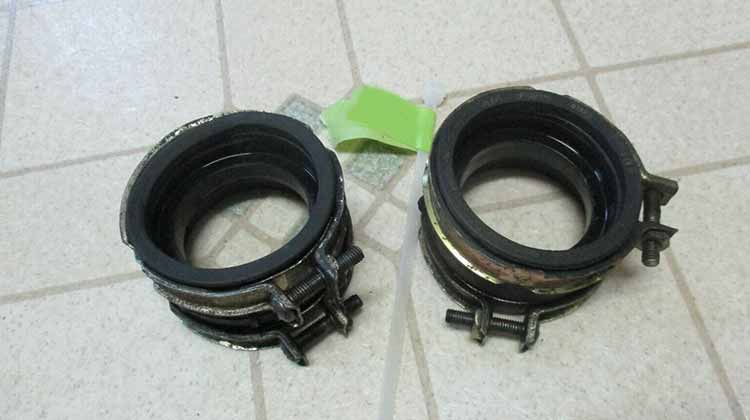
Snowmobile carburetors are held in place by two rubber boots. One of these boots connects the air filter box to the carburetor and serves as the air inlet. A combination of hot and cold conditions, as well as extended periods of sitting idle that is so common with snowmobiles is terrible for rubber. Over time these boots can develop cracks, which leak air into the carburetor and cause your engine to run lean. This problem is a common one with older snowmobiles, and I’ve experienced it with an old Yamaha bravo of mine, which refused to idle properly until I replaced the cracked rubber boot.
On the other side of the carburetor, the other rubber boot connects it to the engine. Any cracks or damages in this boot will also allow excessive air into the snowmobile’s engine, bypassing the carburetor. Now there is a lot more air mixing with fuel, resulting in a very lean mixture of air and fuel. The solution to this is simple and easy. Replace the boots. Even if there is a tiny crack in the boot, it is enough to let a lot of air into the carburetor and engine, which is not going to let your snowmobile run with choke off.
Pilot jet
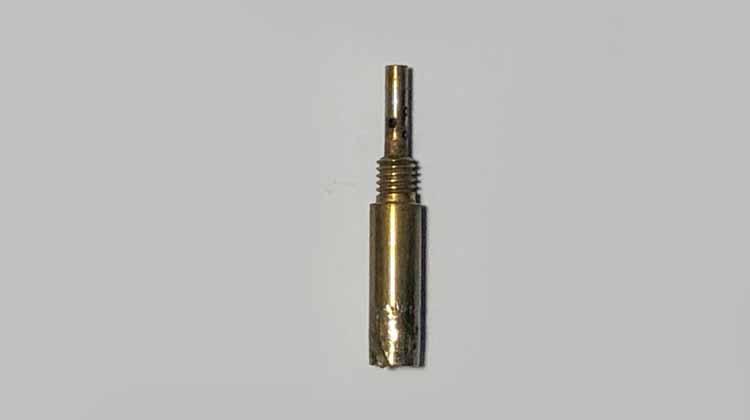
Pilot jets are tiny holes that spray fuel into the carburetor. They are so tiny that even a little bit of dirt or a bit of gummy residual from old gas can clog them. It will result in a noticeable decrease in the supply of fuel. I would suggest you replace these so you can have a reliable snowmobile that guarantees a lot of fun. Cleaning these jets is only possible when you have disassembled the carburetor. You can use a thin wire or needle from the cleaning kit mentioned earlier to remove the blockage. But it’s not always possible to confirm that you have cleaned them properly and fixed the problem.
Main jet
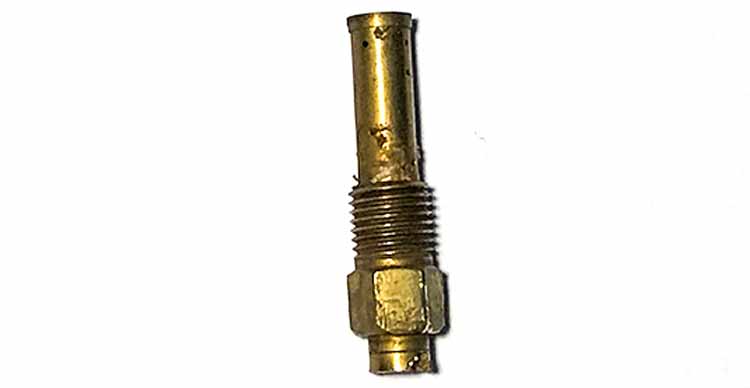
Main jets control the flow of fuel into the carburetor. A blocked or choked up main jet will restrict the flow of gas into the carburetor and will cause the engine to run lean. Main jets are tiny, and it is not uncommon for them to get blocked by dust, but most of the time, impurities in the fuel are what causes the blockage. The only solution is to clean it with a carburetor cleaner and a fine brush from a cleaning kit. You can shine your phone’s flashlight through to make sure you have thoroughly cleaned and removed any blockage.
Fuel Supply
If the carburetor adjustment, cleaning and rubber boot checks do not solve the problem, move on to the fuel supply system.
Fuel Tank Vent
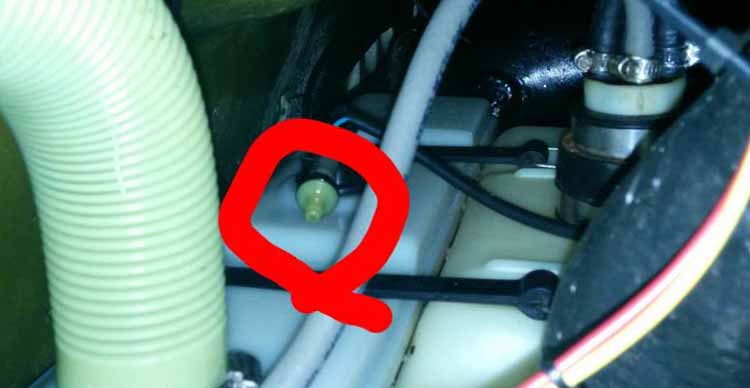
The fuel system starts with the fuel tank. Although you might think the tank is completely sealed, there’s actually a hole in the cap to allow venting and maintain adequate pressure to prevent a vacuum that would stop the flow of fuel. To confirm that the fuel tank is properly vented, open the fuel tank cap and then start your snowmobile. If it runs fine with the fuel tank cap off, then it means that the vent is blocked. You can use a needle to poke the air vent and remove the dirt and debris stuck in there.
Fuel filter
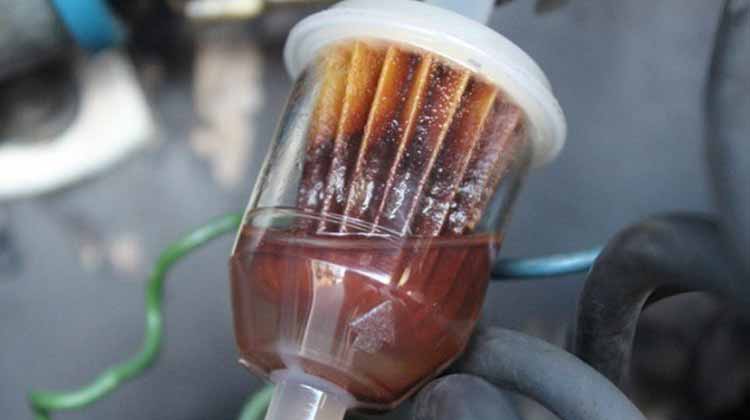
The fuel filter is installed on the hose that links the fuel tank to the fuel pump. It filters any impurities in the fuel, so the engine does not get damaged from these impurities. Over time it gets blocked by the impurities that it has filtered from the gas. Eventually, you will need to replace the fuel filter to restore the flow of gas to the fuel pump from the fuel tank. Some people also suggest washing the fuel filter, but I do not think it is worth it. Fuel filters for snowmobiles are cheap, and replacing them gives you reliability and peace of mind. This inline filter can be easily changed.
Vacuum hose and fuel pump

Most snowmobile fuel pumps are of the diaphragm type. This design consists of the following key parts:
Diaphragm: This flexible membrane acts as the heart of the pump. It pulsates back and forth, creating a vacuum that draws fuel into the pump.
Inlet and Outlet Valves: These valves control the flow of fuel into and out of the pump.
Pulse Line: This line connects the pump to the engine’s crankcase. The pressure fluctuations in the crankcase caused by the pistons moving up and down create the pulsating motion of the diaphragm.
Check Valve: This valve prevents fuel from flowing back into the fuel tank when the pump is not operating.
Fuel Pump Operation:
The fuel pump works in a simple cycle. As the piston in the engine moves down, it creates a pressure increase in the crankcase. This pressure is transmitted through the pulse line to the fuel pump. The increased pressure pushes the diaphragm outward, creating a vacuum in the pump chamber. The vacuum in the pump chamber draws fuel from the fuel tank through the inlet valve. As the piston moves up, the pressure in the crankcase decreases. This decrease in pressure allows the diaphragm to return to its original position. The returning diaphragm pushes the fuel out of the pump chamber through the outlet valve and into the engine’s carburetor or fuel injectors.
Check the vacuum hose for cracks, which cause the vacuum to leak and prevent enough fuel from being supplied to the engine. If you see any cracks or damage in the vacuum hose, replace it. Make sure the new hose is secured tightly to the engine and the fuel pump, and there are no air leaks that could cause the vacuum to break.
If you have replaced the vacuum hose and your snowmobile is still refusing to run without the choke, then your fuel pump might be clogged up. You will need to remove the fuel pump to clean it by using carb cleaner or starter fluid. If it still does not work, then you should replace the fuel pump altogether.
The gaskets
If your snowmobile still only runs on choke, it means that the engine is sucking air from somewhere else. If the problem is not with the carburetor, fuel tank, filter, cap or pump, then you should start looking for leaks on the engine itself.
There are two main gaskets of the engine that, if damaged, can cause air leakage, causing the snowmobile to run lean. These are the head gasket, the base gasket, and the crank-case itself. The gaskets and seals are durable and last many years if the engine is maintained properly. If you do not take basic care of your snowmobile (or any vehicle), these gaskets are going to get worse and cause air leaks.
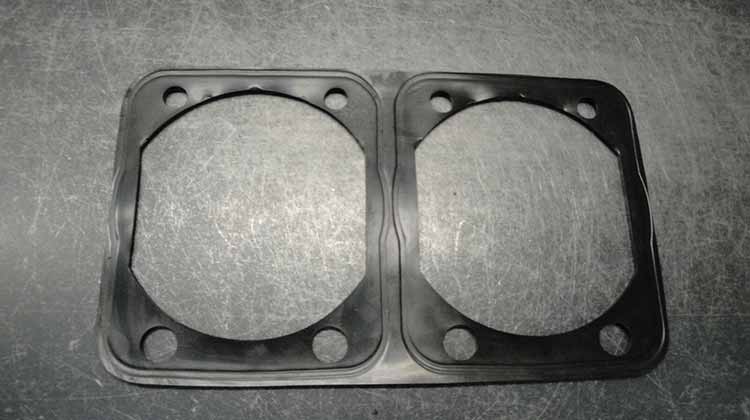
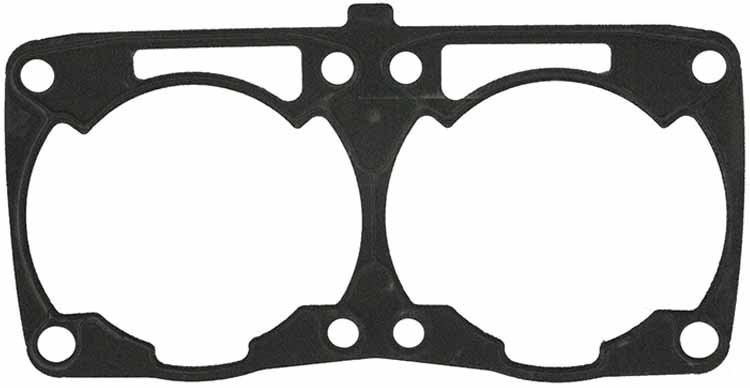
You can find the leak yourself by spraying starter fluid or carburetor cleaner on the seals or the crank case, while the engine is running. If there are any air-leaks, the fluid will get sucked inside with air. In this case, I would suggest you to take it to a mechanic so they can perform a proper leak test and fix the problem.
In Conclusion…
I hope that this post has helped you to figure out why your snowmobile will only run with the choke on. There can be several solutions to each problem, and these are the most common based on my experience and research. Happy riding!